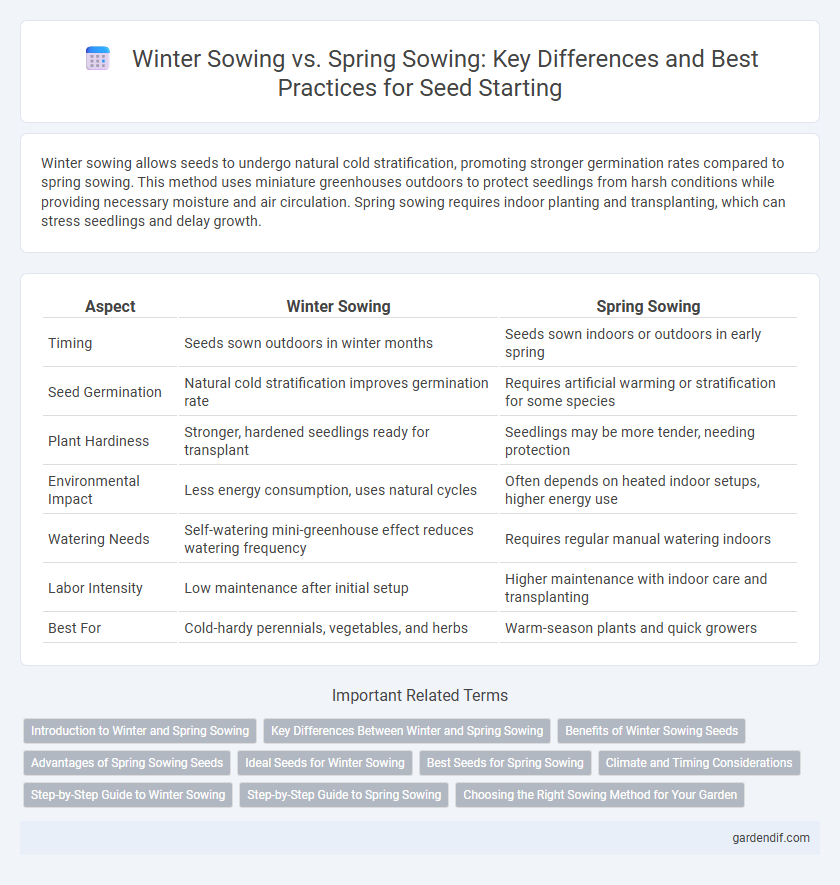
Winter sowing vs Spring sowing Illustration
Winter sowing allows seeds to undergo natural cold stratification, promoting stronger germination rates compared to spring sowing. This method uses miniature greenhouses outdoors to protect seedlings from harsh conditions while providing necessary moisture and air circulation. Spring sowing requires indoor planting and transplanting, which can stress seedlings and delay growth.
Table of Comparison
| Aspect | Winter Sowing | Spring Sowing |
|---|---|---|
| Timing | Seeds sown outdoors in winter months | Seeds sown indoors or outdoors in early spring |
| Seed Germination | Natural cold stratification improves germination rate | Requires artificial warming or stratification for some species |
| Plant Hardiness | Stronger, hardened seedlings ready for transplant | Seedlings may be more tender, needing protection |
| Environmental Impact | Less energy consumption, uses natural cycles | Often depends on heated indoor setups, higher energy use |
| Watering Needs | Self-watering mini-greenhouse effect reduces watering frequency | Requires regular manual watering indoors |
| Labor Intensity | Low maintenance after initial setup | Higher maintenance with indoor care and transplanting |
| Best For | Cold-hardy perennials, vegetables, and herbs | Warm-season plants and quick growers |
Introduction to Winter and Spring Sowing
Winter sowing involves planting seeds outdoors in containers during cold months, allowing natural stratification and germination as temperatures rise. Spring sowing typically occurs indoors or in heated environments, providing seedlings a controlled climate before transplanting. Both methods optimize seed germination timing but differ in environmental dependency and preparation requirements.
Key Differences Between Winter and Spring Sowing
Winter sowing involves planting seeds outdoors in insulated containers during cold months to promote early germination using natural temperature fluctuations, while spring sowing takes place after the last frost when soil and air temperatures stabilize. Seeds sown in winter often experience slower, more gradual growth and develop hardier root systems, whereas spring sown seeds tend to germinate faster with less risk of cold damage but may yield shorter growing seasons. Choosing between winter and spring sowing depends on seed type, climate zone, and desired harvest timing to optimize plant health and productivity.
Benefits of Winter Sowing Seeds
Winter sowing seeds promotes stronger seedling resilience by exposing seeds to natural cold stratification, which breaks dormancy and encourages more uniform germination. This method conserves water and reduces the risk of damping-off disease by allowing seeds to germinate outdoors in a controlled microenvironment. Gardeners benefit from an extended growing season, resulting in earlier transplants and enhanced plant vigor compared to traditional spring sowing.
Advantages of Spring Sowing Seeds
Spring sowing seeds benefits from warmer soil temperatures that promote faster germination and seedling growth, leading to a stronger start for many plant varieties. This method allows for a longer growing season, maximizing the potential yield and enabling early harvests. Moreover, spring sowing reduces the risk of frost damage, which can be detrimental to delicate seedlings started in winter conditions.
Ideal Seeds for Winter Sowing
Ideal seeds for winter sowing are hardy perennials, cold-tolerant annuals, and biennials such as pansies, lettuces, and kale that can germinate in cool, fluctuating temperatures. These seeds benefit from natural stratification provided by outdoor cold exposure, promoting strong root development before spring. Selecting cold-hardy varieties ensures successful germination and early growth during winter sowing compared to more delicate seeds suited for spring planting.
Best Seeds for Spring Sowing
Best seeds for spring sowing include cold-tolerant vegetables such as peas, spinach, and radishes, which thrive in early emerging soil moisture and moderate temperatures. Warm-season crops like tomatoes, peppers, and cucumbers require starting indoors or waiting until after the last frost for optimal growth. Choosing seeds with high germination rates and disease resistance improves spring planting success, ensuring robust seedlings ready for outdoor transplanting.
Climate and Timing Considerations
Winter sowing leverages cold stratification by planting seeds outdoors in mini greenhouses during the cold season, allowing natural temperature fluctuations to trigger germination as spring arrives. Spring sowing requires warmer soil temperatures, typically above 50degF (10degC), making it crucial to time planting after the last frost to ensure seedling survival. Climate plays a significant role; winter sowing is ideal in regions with predictable cold winters, while spring sowing suits warmer climates with shorter frost periods.
Step-by-Step Guide to Winter Sowing
Winter sowing involves planting seeds in mini greenhouses outdoors during the cold months, enabling natural stratification and earlier germination compared to traditional spring sowing. Start by selecting hardy seed varieties, fill containers with a well-draining seed-starting mix, and sow seeds on the surface with minimal coverage before sealing the lid to create a mini greenhouse environment. Place containers in a sunny, sheltered location where temperature fluctuations promote seed dormancy breaking, and monitor moisture levels until seedlings emerge in early spring.
Step-by-Step Guide to Spring Sowing
Spring sowing requires preparing seed trays with quality potting mix, evenly distributing seeds according to depth recommendations, and maintaining consistent moisture for optimal germination. Place trays in a warm, well-lit area, monitoring daily and thinning seedlings to prevent overcrowding and promote healthy growth. Gradually acclimate young plants to outdoor conditions before transplanting to ensure successful establishment in garden beds.
Choosing the Right Sowing Method for Your Garden
Winter sowing leverages cold stratification to improve seed germination rates for cold-hardy plants by mimicking natural outdoor conditions. Spring sowing offers the advantage of starting seeds indoors under controlled environments, allowing for earlier transplanting and faster growth. Gardeners should choose winter sowing for hardy perennials and vegetables requiring cold exposure, while spring sowing suits tender annuals and heat-loving crops to maximize overall garden productivity.
Winter sowing vs Spring sowing Infographic

 gardendif.com
gardendif.com